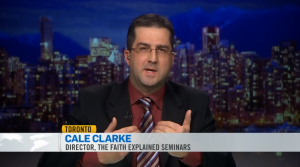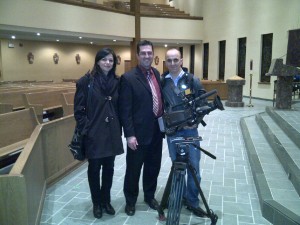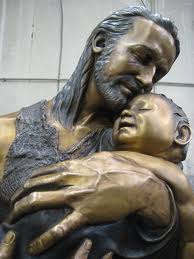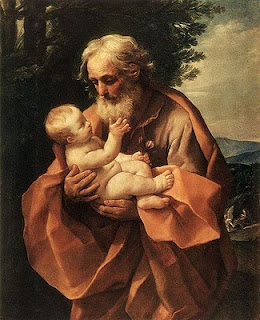 Hi Everybody, just a note to let you know you can watch the interview I had tonight with Scott Laurie of CTV News about all things papal online here!
Hi Everybody, just a note to let you know you can watch the interview I had tonight with Scott Laurie of CTV News about all things papal online here!
Posts
B16 will be tweeting from his new @Pontifex account tomorrow! Not sure if he’ll use an iPad, but we do know the Holy Father is a huge fan of those two older tablets…I’ll be in studio on CTV News Channel to break down this milestone in Gospel communications. Look for me somewhere between 10-10:30 9:30-10 AM Eastern, probably around 9:45.
 Here’s my latest article from the June issue of Catholic Insight magazine. Hope you like it!
Here’s my latest article from the June issue of Catholic Insight magazine. Hope you like it!
Debunking the Debunkers
by Cale Clarke
Just as surely as the lillies bloom every spring, each Easter season brings with it some new theories about what really happened at the first Easter. Martin Luther’s dictum describing early Protestantism comes to mind: “There are as many interpretations as there are heads”. Here are a couple of this year’s takes:
First, on Holy Saturday, the National Post ran a piece about a new book by art historian (and amateur theologian) Thomas de Wesselow, The Sign: The Shroud of Turin and the Secret of the Resurrection. And what, pray tell, is that secret? According to de Wesselow, the shroud really is the burial cloth of Jesus Christ – but get this: he thinks it was the shroud that the Apostles encountered after the death of Christ, not his resurrected body. Huh? So, when “doubting” Thomas stuck his hand in Jesus’ side, was he only wiggling his fingers through a hole in the sheet? Not sure this is the sort of stuff that inspires martyrdom.
And then there’s the perennial publicity hound Simcha Jacobovici (TV’s The Naked Archaeologist), who, along with James Cameron (whenever the latter is not tied up making bad movies about blue people or sinking boats), spends a lot of his time looking for the lost tomb of Jesus. It’s a project that has as much potential as the maiden Titanic voyage.
As real biblical scholar Craig Evans pointed out recently in The Huffington Post, the archaeological community scoffs at the idea that the tomb in the Jerusalem area that Jacobovici shows off in The Jesus Discovery belongs to Jesus of Nazareth. And, if Jesus’ bones are still in a tomb, then how does Jacobovici explain the fact that even the enemies of the early Christian movement say it’s empty? It seems as if The Naked Archaeologist has no clothes.
The fact is that the disciples claimed to have encountered the resurrected Jesus. People who days earlier had denied even knowing Jesus (like Peter) are, post-Easter, quite willing to lay down their lives for their conviction that Jesus lives. Skeptics, even persecutors like Saul the Pharisee (better known now as Paul the Apostle) claim to have had the same experience. After his death and burial, Jesus is said to have appeared to numerous individuals and groups of people over a 40-day period, including 500 people at one time (1 Corinthians 15:6). Forget about mass hallucinations – you can’t catch a hallucination like a common cold. And what these folks claimed was not even that they had seen a “vision” of Jesus – a category well accepted in Jewish circles.
No, what they claimed was not that they had seen a ghost, or even – sorry, Thomas de Wesselow – a shroud. They claimed to have experienced Jesus’ physical body, back from the dead. Transformed, yes, but still him, still sporting the crucifixion wounds as a type of I.D. Able to be touched, able to scarf down some food to make a point of his being corporeal (cf. Luke 24:36-43; Acts 10:41). A resurrection is a lot harder to prove than a vision. A “vision” of Jesus, encouraging the disciples to continue the mission, wouldn’t require an empty tomb. And preaching the resurrection in the very city where Jesus was crucified would have been impossible if the tomb were occupied. This is even more evident when one considers that the location of the tomb was no secret, not waiting thousands of years to be discovered by Cameron and Jacobovici – it belonged to Joseph of Arimathea, a member of the Sanhedrin, the very council which condemned Jesus to death, and a known public figure.
Could the disciples have stolen the body? That was, after all, the explanation proffered by the enemies of the nascent Church as to how the tomb came to be empty. But this view overlooks an important fact: the disciples died for their belief in the resurrection. True, many have died (and continue to do so) for what they believe to be true – suicide bombers, for instance. But no one in their right mind willingly would give their life for what they knew to be false. If the disciples really had Jesus’ body locked in the trunk of a car somewhere, I doubt they’d be in a hurry to get themselves crucified upside-down, or sawed in two.
Whatever one’s theory is about what happened that first Easter, one ought to at least take into account all the known facts of the case. But, unfortunately for a gullible public, the Jacobovicis and de Wesselows of the world have never let the facts get in the way of a good story.
Cale Clarke is the Director of The Faith Explained Seminars (TheFaithExplained.com), and the creator of The New Mass app.
 Today’s first reading from 1 Corinthians 15 contains one of the first “creeds” of the early Church. As Saint Paul writes,
Today’s first reading from 1 Corinthians 15 contains one of the first “creeds” of the early Church. As Saint Paul writes,
“For I handed on to you as of first importance what I also received:
that Christ died for our sins
in accordance with the Scriptures;
that he was buried;
that he was raised on the third day
in accordance with the Scriptures;
that he appeared to Cephas, then to the Twelve.
After that, he appeared to more
than five hundred brothers at once,
most of whom are still living,
though some have fallen asleep.
After that he appeared to James,
then to all the Apostles.
Last of all, as to one born abnormally,
he appeared to me.”
– 1 Corinthians 15:3-8
In an interview with Lee Strobel for the book The Case for Christ, scholar Gary Habermas showed that Saint Paul is, in fact, quoting a very early creed of the Church. First, Paul uses the terms translated “received” and “handed on”, technical rabbinical language for the passing on of sacred tradition. The text is also in stylized format, using parallelism, presumably to aid memorization. The use of the Aramaic version of Peter’s name, “Cephas” is likely a sign of its primitive date. The creed also uses phrases that are uncommon in Paul’s writings: “the Twelve”; “he was raised”; “the third day”. Habermas noted that scholar “Ulrich Wilkens says that it ‘indubitably goes back to the oldest phase of all in the history of primitive Christianity'” (Strobel, The Case for Christ, p. 230).
Habermas, among others, would contend that this creed could have been composed within mere months after the resurrection of Jesus. He notes that no credible scholar disputes Pauline authorship of 1 Corinthians, which was likely written between 55-57 AD. But Paul says in 15:3 that he passed the creed on to the Corinthian Church at some point in the past, predating his visit there in 51 AD. That places the composition of the creed no later than within 20 years of the original Easter event.
But Habermas – and others – think the creed goes back even further: between 32-38 AD, when Paul received it, in all likelihood in Jerusalem. Three years after Paul’s conversion, he travelled to Jerusalem to interview the Apostles Peter and James (whose feast day we celebrate today). Habermas draws our attention to the fact that, when Paul described this trip in Galatians 1:18-19, he uses the Greek word historeo, which indicates a thorough investigation of the facts surrounding Jesus’ resurrection was being made. So, in all likelihood, this creed was delivered to Paul by the eyewitnesses of the resurrected Jesus, Peter and James.
Of course, the creed goes on to enumerate other Easter eyewitnesses, including an appearance of the Risen Christ to over 500 people at once – “most of whom are still living” at the time Paul wrote 1 Corinthians. Paul is virtually daring any skeptics to interview these people.
The 1 Corinthians creed authenticates the resurrection of Christ in many ways, not the least of which is this: its incredibly early, eyewitness testimony precludes any possibility of legendary accretion. The fact is, the resurrection is a fact.
 In case you didn’t catch my interview on CBC’s The National on Easter Sunday, the segment on religion and technology has now been posted online here:
In case you didn’t catch my interview on CBC’s The National on Easter Sunday, the segment on religion and technology has now been posted online here:
I thought the piece was pretty thought-provoking. Different religions obviously have varying takes on the limits of technology in one’s faith journey. I’d love to hear your opinion in the comments box below!
 I’ll be appearing on CBC’s The National tomorrow, Easter Sunday. I was part of a story by Nahlah Ayed on religion and technology that promises to be very thought-provoking. Nahlah asked me about how – and why – I created The New Mass app for iPhone and Android, the first app for the new English translation of the Mass. We also talked about the proper place of technology in the Catholic life – how it helps, and what its limits might be. Here I am pictured with Nahlah and cameraman Marc Cormier. I’d like to thank the CBC crew for being so gracious and fun to work with – not only Nahlah and Marc, but also Tashauna Reid, who did such a great job of producing. Can’t wait to see how it all turned out!
I’ll be appearing on CBC’s The National tomorrow, Easter Sunday. I was part of a story by Nahlah Ayed on religion and technology that promises to be very thought-provoking. Nahlah asked me about how – and why – I created The New Mass app for iPhone and Android, the first app for the new English translation of the Mass. We also talked about the proper place of technology in the Catholic life – how it helps, and what its limits might be. Here I am pictured with Nahlah and cameraman Marc Cormier. I’d like to thank the CBC crew for being so gracious and fun to work with – not only Nahlah and Marc, but also Tashauna Reid, who did such a great job of producing. Can’t wait to see how it all turned out!
 After attending the Mass of the Lord’s Supper tonight, commemorating the institution of the Mass that first Holy Thursday, many stayed in a silent vigil with our Eucharistic Lord. While praying before the altar of repose, I reflected on what Jesus taught his Apostles that night. As always, he lived his own teaching, his words matching his deeds exactly. He had told them, “By this all people will know that you are my disciples, if you have love for one another” (John 13:35). And that love should be manifested in humble service. Christ demonstrated it by taking on the role reserved for the lowest servant: the Lord of the universe washed his disciples’ feet.
After attending the Mass of the Lord’s Supper tonight, commemorating the institution of the Mass that first Holy Thursday, many stayed in a silent vigil with our Eucharistic Lord. While praying before the altar of repose, I reflected on what Jesus taught his Apostles that night. As always, he lived his own teaching, his words matching his deeds exactly. He had told them, “By this all people will know that you are my disciples, if you have love for one another” (John 13:35). And that love should be manifested in humble service. Christ demonstrated it by taking on the role reserved for the lowest servant: the Lord of the universe washed his disciples’ feet.
This Easter, what may wind up convincing people of the truth of our faith may not be the impressive array of arguments at our disposal that authenticate the Resurrection of Jesus as a historical event, although we should use them whenever we can. It may in fact be something less intellectual, but no less real: our love and service on behalf of others, in Jesus’ name. Some are “caught” by the head; others, by the heart.
 Now that we’ve looked briefly at the case for Saint Joseph as an older man in our last post, how about the other side of the argument? Is it possible that Saint Joseph was a younger man when he became the adoptive father of Jesus? Under this view, it would still be possible to hold the opinion that Joseph knew about Mary’s prior commitment to consecrated virginity, or (far more unlikely) that they were planning a “normal” marriage prior to Mary’s discovery of her unique vocation to be the Mother of the Messiah?
Now that we’ve looked briefly at the case for Saint Joseph as an older man in our last post, how about the other side of the argument? Is it possible that Saint Joseph was a younger man when he became the adoptive father of Jesus? Under this view, it would still be possible to hold the opinion that Joseph knew about Mary’s prior commitment to consecrated virginity, or (far more unlikely) that they were planning a “normal” marriage prior to Mary’s discovery of her unique vocation to be the Mother of the Messiah?
Here’s what St. Josemaria Escriva, who had a tremendous devotion to St. Joseph, said about the matter in a homily about St. Joseph in 1963:
“I don’t agree with the traditional picture of St Joseph as an old man, even though it may have been prompted by a desire to emphasise the perpetual virginity of Mary. I see him as a strong young man, perhaps a few years older than our Lady, but in the prime of his life and work…You don’t have to wait to be old or lifeless to practice the virtue of chastity. Purity comes from love; and the strength and gaiety of youth are no obstacle for noble love. Joseph had a young heart and a young body when he married Mary, when he learned of the mystery of her divine motherhood, when he lived in her company, respecting the integrity God wished to give the world as one more sign that he had come to share the life of his creatures. Anyone who cannot understand a love like that knows very little of true love and is a complete stranger to the christian meaning of chastity.”
I suppose an important question in this debate is this: How old is old? perhaps a type of “hybrid” view makes the best sense. For example, Joseph could have married Mary when he was about 25-30 years old (with Mary being, in all likelihood, no more than 16, according to the majority of New Testament scholars). Joseph would have still possessed a relatively “young body”, as St. Josemaria put it, able to withstand the rigors of the flight into Egypt and the journey back to Nazareth some time later. He would have been capable of working hard for many years and protecting Jesus and Mary, as well as providing for their necessities.
The average life span of men in the first century in the Roman Empire was considerably less, however, than what we enjoy today. Thirty years later, when Jesus began his ministry, it is more than concievable that Joseph, approaching sixty, may have already passed away.
 The recent Solemnity of Saint Joseph on March 19 was a welcome feast within Lent – and we’ll have another one next week: the Annunciation. When contemplating Saint Joseph, one of the many interesting unanswered questions about him is this: How old was he? Was he an older man who served as a guardian to the Virgin, or was he younger and more robust? I’ll lay out the two competing views in the next couple of posts. First up: the view that he was older.
The recent Solemnity of Saint Joseph on March 19 was a welcome feast within Lent – and we’ll have another one next week: the Annunciation. When contemplating Saint Joseph, one of the many interesting unanswered questions about him is this: How old was he? Was he an older man who served as a guardian to the Virgin, or was he younger and more robust? I’ll lay out the two competing views in the next couple of posts. First up: the view that he was older.
The Eastern wing of the Church has traditionally held that Saint Joseph was an older man, who betrothed and married Mary not for the purposes of romance, but protection – to be her legal guardian, as it were. The thinking here is that Mary had always planned on remaining a virgin dedicated to the service of God. Admittedly, this was a relatively rare position to take in Israel in the first century. But there are other examples, even in the same generation: Jesus himself (obviously), Saint Paul, and some of the Essenes, for starters. One could also add the prophetess Anna mentioned by Luke (2:36-38), who, although briefly married in her youth, lived out the rest of her days worshipping in the temple, consecrating herself to the Lord. She ostensibly could have sought remarriage, but didn’t. Mary may have been planning a similar life for herself.
But being an unmarried woman in the first century, especially if one was without extended family members to rely upon, may have been a precarious position to be in. Having a guardian, in the form of an older Saint Joseph, would have been a boon. Mary’s question to the archangel Gabriel, when told she would be the mother of the Messiah (“How can this be, since I am a virgin?” – Lk 1:34) is quite an odd question for an engaged woman to ask. Gabriel has said nothing at this point about the conception of Jesus being miraculous in nature – he does that a few verses later. Odd, that is – unless she was planning on remaining a virgin all along.
The concept of Joseph as an older man also carries explanatory power in other ways: most notably, it explains his absence from the adult ministry of Jesus. The presumption is that he had died by this point. Although the mother of Jesus is mentioned at key points in the ministry of the Lord, Joseph is nowhere to be found. This is felt most acutely at the crucifixion, where Jesus gives the care of his mother into the hands of – not Joseph, but the apostle John – inconceivable if Joseph had been living at the time (Jn 19:26-27). As well, in some strains of this tradition, Joseph is said to have been a widower, whose first wife had died some time before, when he married the Virgin. This may shed some light on who the alleged “brothers and sisters” of Jesus might have been. Certainly, they were not other children of Mary, but they may have been Joseph’s children from his previous marriage.
What do you think? Sound off in the comments box, but don’t forget to stay tuned for the other side of the argument, which I haven’t even presented yet – that Joseph was a much younger man. We’ll tackle that argument in the next post.

Today the Church celebrates Candlemas, otherwise known as the feast of the Presentation of the Lord, the Light of the World (Luke 2:22-40). It was in Gaul (modern-day France) that processions with candles began to mark this event, the official end of the celebration of the Nativity.
Jesus, like all Jewish firstborn sons, was consecrated to the Lord. Mary and Joseph took the child to the temple in Jerusalem at the time he was to be circumcised and offered the sacrifice of two pigeons, the offering of a poor couple who could not afford a more expensive animal sacrifice. Only Mary and Joseph, and possibly Simeon and Anna would have known that the ultimate and final sacrifice, the true Lamb of God, was being presented in the temple. And only they would have known that here was the true temple – the Body of Christ (cf. John 2:19-22 ).
The Ark of the Covenant, which used to be housed in the Jerusalem Temple, had been missing since Jeremiah hid it from invading marauders in 586 BC. Yet, the true Ark, the Ark of the New Covenant, Mary, was now entering the temple with her divine Son. She brought the Light of the World into the world. Saint Alphonsus of Liguori, in The Glories of Mary, says, “Saint Simeon received a promise from God that he should not die until he had seen the Messiah born…but he did not receive this grace except by means of Mary, for he did not see the Savior until he saw him in the arms of Mary. Hence, whoever wishes to find Jesus, will not find him except through Mary.”

